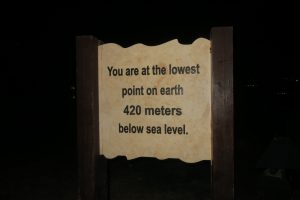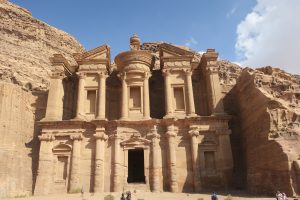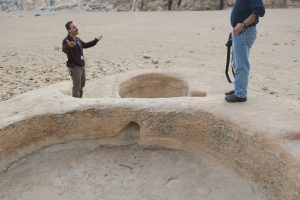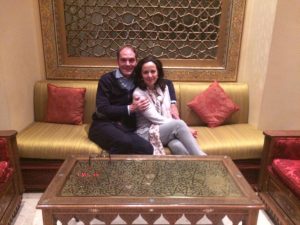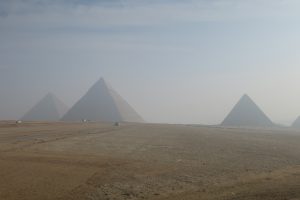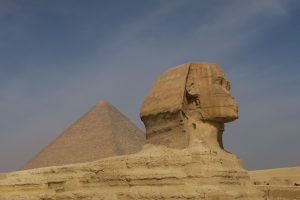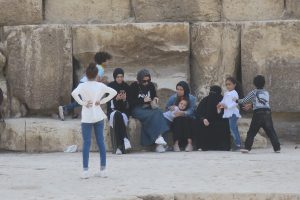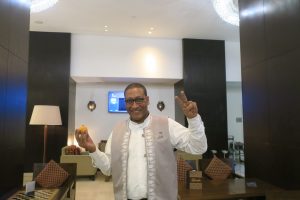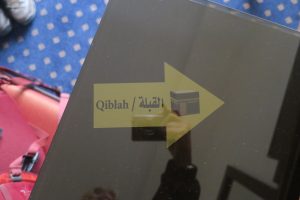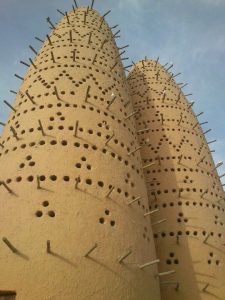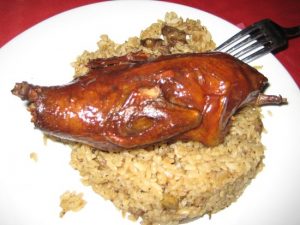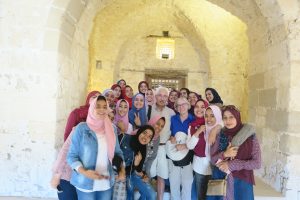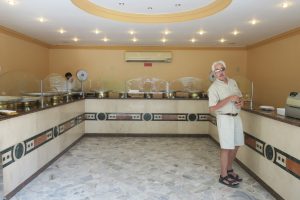We started the day by visiting Memphis, a former Egyptian capitol in the Old Kingdom founded by the first pharaoh. while there we visited the Colossus of Ramesses II, an enormous statue, 34 ft long, carved in limestone. It was discovered in 1820 and a small museum was built around him. He is shown lying on his back. His legs are missing but he is still impressive. At the museum there were a number of other artifacts unearthed in the area.
Next stop Dashur Pyramid. Many people don’t realize that there are over 100 pyramids in Egypt.
Building the Dahshur pyramids was an extremely important learning experience for the Egyptians. It provided them with the knowledge and know-how to transition from step-sided pyramids to smooth-sided pyramids. Ultimately their breadth of experience would allow them to build the Great Pyramid of Giza, the last of the Seven Wonders of the Ancient World still standing.
The first of the Dahshur pyramids was the Bent Pyramid (2613 – 2589 BC), built under the rule of King Sneferu. The Bent Pyramid was the first attempt at building a smooth sided pyramid, but proved to be an unsuccessful build due to the miscalculations made on the structural weight and angle of accent. Realizing the shortcomings from the initial build and learning from his mistakes King Sneferu ordered the building of the second pyramid of Dahshur, the Red Pyramid. Once completed, the pyramid was considered to be a success, as it was a fully constructed, smooth sided, and a free standing pyramid rising to a height of 341 feet, with an angle of accent of 43 degrees. The Red Pyramid’s name comes from the red limestone that was used to construct the pyramid. This pyramid is believed to be the resting place of King Sneferu.
Nahed didn’t walk around the Pyramid with us. We had an armed guard walking with us. Nahed told the guard we are American which typically results in an armed escort. Often when we pull up to check points they tell the guards that we are British because they don’t want to wait for the armed guard. This must explain our escort in Dendera.
We went into the Red Pyramid which has 136 steps leading to a large chamber and a small tunnel which leads to another tunnel, some more steps and another chamber.
Here are some pictures.
Our last sight seeing stop was Saqqara. We visited the several tombs including one of Menu, a Vizier from about 4,000 years ago. Archeologists say its colorful wall decorations shed light on how Egyptians lived back then. Unlike the tombs in the Valley of the Kings and Queens which show images of royalty passing from life to death, these tombs depicted daily life. It was really amazing. We couldn’t take pictures but here are some I downloaded.
The Step Pyramid of Djoser was in the same compound. Built in the 27th century BC, it is the oldest complete stone building complex known in history. Another 16 Egyptian kings built pyramids at Saqqara which are now in various states of preservation or dilapidation. There is also a funerary complex. Here are some pictures.
Lunch was next on the agenda. We stopped at an open air restaurant and had a very nice lunch after which we returned to our hotel.
After relaxing a little, we decided to walk to Tahrir Square, site of many protests during the revolution. We were accosted by vendors four times during our 1 mile walk. They all started with, “hi where are you from”, then, “I have a cousin who lives in…”, eventually, “come to my store.” They all seemed to have someone getting married the next day so we actually got invited to one fellow’s daughter’s wedding on the Nile. One person said this way to Tahir Square and misled us to his store. Once we were in the store he left us to his colleague to give us the pitch while he went and recruited more tourists. The colleague tried the free gift tactic but we weren’t falling for it and quickly left the store. It was all fine, as they say, no harm, no foul. Tahrir Square was somewhat anti climatic, here’s a picture.
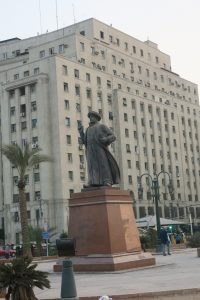
Here are some other pictures from our walk in Cairo.
That evening we went to our favorite Egyptian restuarant in the hotel. I have been knitting in the car and Nahed, our guide, asked me to make her something, so I was working on a strawberry bookmark for her at dinner. The bartender, with whom we have become friendly, liked it as asked for something. I’m covering Egypt with knitted trinkets!





















